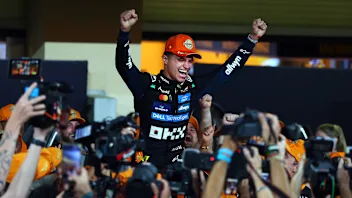The 2014 Formula 1 Petronas Malaysia Grand Prix, like the Australian round which opened the new season a fortnight ago, won’t give us all of the answers about the pecking order under the new rules, but it will uncover a little more of the truth.
With much higher humidity and soaring ambient temperatures - between 45 and 41 degrees Celsius compared to Melbourne’s 27 and 19 - the race in Kuala Lumpur will throw up a whole different range of issues for the teams and drivers to deal with.
The Sepang track is somewhat abrasive but relatively free of bumps after resurfacing following the 2007 race, and the kerbs are also less of a problem here than at some other tracks. There are also two very long and fast straights which will see maximum speeds close to 340 km/h. Because of this, the track is also relatively hard on brakes, which may expose those still struggling with their fly-by-wire rear brake systems. Traction is also crucial here, especially exiting the tight corners at the end of each straight, while a neutral handling balance is critical in the numerous fast sweeps.
The biggest factor, however, will be the strain imposed on the power units, with the heat and humidity expected to quickly expose any flaws in a car’s cooling.
Again, managing fuel consumption will be a significant issue, while the internal combustion engine itself will be under the biggest load. The humidity in Sepang normally helps the engines as power reduces when water content in the air increases. But now that the engines are turbocharged the air intake is controlled all of the time regardless of ambient temperature, so the two long straights will put the V6s under a lot of pressure.
“This race is one of the hardest of the year for the power unit due to the long straights,” explains Caterham’s Renault Sport F1 track support leader, Cedrik Staudohar. “The high air temperature is usually a concern as we have to choose the correct cooling level. The high chance of rain could also make the cars difficult to control due to the increased torque and lack of grip so the focus will be on good driveability without too much wheelspin.
“As for the main energy recovery points, the two long straights of over a kilometre each give plenty of opportunity for the MGU-H to be recharged. The heavy braking points of the hairpin (Turn 15), the first corner complex and the mid-to-low speed corners in the third sector should allow the MGU-K to recover energy to feed back into the battery.”
Mercedes have to start as favourites after Nico Rosberg’s runway victory in Australia, but Lewis Hamilton’s engine problem there raises an inevitable question mark over reliability.
“While we were pleased to come away from Melbourne with a win, we were also left with plenty to think about,” admits Paddy Lowe, Mercedes’ executive director (technical). “As is to be expected with such new technology, we are learning more about the car with every lap. This inevitably brings more problems to the surface, all of which require careful management. Our priority has therefore been to arrive in Malaysia in better shape mechanically than we left Australia.
“This race presents a very different set of challenges in terms of both the climate and the demands of the circuit layout. Sepang is a permanent race track which is generally a lot more differentiating of the cars; particularly with regard to aerodynamics. As always, reliability and endurance will be crucial, but we believe this venue will provide a more accurate representation of the relative pace between teams.”
As the home race for team sponsor Petronas, who celebrate their 40th anniversary this season, Malaysia is doubly important for Mercedes, and Rosberg will be looking for another helping of 25 points to increase his early championship lead.
“Sepang holds some great memories for me as I achieved my first podium for Mercedes here at the start of the 2010 season,” Rosberg says. “Normally the weather is seen as the biggest challenge here but this season is different, with reliability the focus of everyone's attention. Of course, it will still be hot, humid and probably wet at some stage too, so it should be a fascinating weekend. Australia was the perfect start to my season, but it also highlighted that we're not 100 percent there yet in terms of reliability. We've had two weeks before this race to identify all the things that we can do better, so hopefully we can bring both cars home for a good result this weekend and continue our strong start to the year.
"We have to keep the momentum going and not let our rivals catch up. That is the most important thing: to keep pushing. We were confident and now the pace is obvious. We are quick. We are the fastest car, which is awesome. It is such a cool feeling. It’s so great."
“Malaysia forms one of three home races for the team alongside Germany and Great Britain,” Rosberg’s team mate Hamilton says. “We have some exciting events planned with Petronas during the days building up to the race weekend so it will be a busy week but a lot of fun. I finished second on my Formula One debut here in 2007 and have been on the podium at the last two Malaysian Grands Prix but I've yet to win here. It would be amazing to stand on the top step at one of our home races and I'm looking forward to bouncing back after a tough weekend in Australia.”
On current form Mercedes are the pacesetters, but Red Bull’s speed in Melbourne came as a surprise to many and Sebastian Vettel will be going all-out to open his points score. Team mate Daniel Ricciardo had a great race in his homeland until the stewards disqualified his car for a fuel flow indiscretion, so he will be on a mission to redress that this weekend.
At Williams, Felipe Massa is itching to show what the Mercedes-powered FW36 can do on a circuit that really suits his driving style, while his team mate Valtteri Bottas is another seeking to make amends after the wall-kissing incident in Albert Park’s Turn 10 which probably cost him a maiden podium finish.
And Ron Dennis says that McLaren expect to find another half second with a revised aero and engine mapping package that will help Jenson Button and Kevin Magnussen to maintain the team’s lead in the world championship for constructors.
“Australia was a really motivational race for the entire team,” Button says. “Even though we still have work to do, it feels like we’ve turned a corner, and that we have a racecar we can definitely work with this year.”
Meanwhile, sensational team mate Magnussen adds: “Sepang is a very different type of track from Albert Park: Melbourne was all about slow-speed corners and mechanical balance, whereas Malaysia is a real high-speed circuit, the corners are much faster and there’ll be more of an emphasis on aerodynamic performance.
“I think it’ll be a tougher test than Australia - the ambient temperatures will make it tougher for the drivers; and the track temperatures will be higher too, which will make it harder on the tyres. My aim will be to score more points - consistency is going to be very important for the championship - and to keep learning, especially in such a different environment.
“I’m really looking forward to it - the car feels fantastic to drive, and I hope we’ll have another good weekend.”
Elsewhere, Force India and Toro Rosso believe they will be able to run Ferrari close, on Melbourne form, as Caterham and Marussia have their eyes focused on Sauber’s lower midfield position. The Swiss team will be hoping that their rear brake problems have been fixed after an unhappy time Down Under. Finally, Lotus have their own mountain to climb after all of the problems that have beset the E22 after its delayed debut.
Pirelli will be bringing their orange-marked hard and familiar white-marked medium tyres to this race, as their two hardest compounds are ideal for the extreme temperatures and abrasive surface of Sepang. Given the extremely high likelihood of rain, the green-marked intermediate and blue-marked full wet tyres will almost certainly be used as well.
Pirelli’s motorsport director Paul Hembery explains: “Malaysia will obviously be only the second race that this completely new range of tyres, designed for the latest-generation Formula One cars, have ever competed in, and it also marks the debut of our 2014 hard tyre. The medium performed well in Melbourne, but Malaysia obviously presents a big contrast to Australia. We go from the smooth asphalt in Melbourne to a highly abrasive surface, and from the relatively cool conditions of Albert Park to much higher ambient and track temperatures. This of course will be as much of a challenge for the new cars as it is for the drivers, and we mustn’t forget that we are still at a very early point in the overall learning curve.
“Wet conditions in qualifying in Australia allowed the teams to sample the 2014 intermediate and full wet tyres, and this knowledge could become very useful in Sepang.”
The 5.543 kilometre (3.444 mile) circuit is largely unchanged save for a few revised kerbs, and retains two DRS zones, the first between Turns 14 and 15 and the second between Turn 15 and Turn 1. Sunday’s race will run over 56 laps or 310.408 kilometres (192.887 miles). It starts at 1600 hours local time, which is eight hours ahead of GMT.
Next Up
Related Articles
 10 ways to get your Formula 1 fix during the winter break
10 ways to get your Formula 1 fix during the winter break ExclusiveVesti on life as Mercedes reserve and his F1 plan
ExclusiveVesti on life as Mercedes reserve and his F1 plan EXPLAINED: The key terms for F1’s new-for-2026 rules
EXPLAINED: The key terms for F1’s new-for-2026 rules Celebrating the first F1 Allwyn Global Community Awards
Celebrating the first F1 Allwyn Global Community Awards F1 AcademyHaas name Countryman as 2026 F1 ACADEMY driver
F1 AcademyHaas name Countryman as 2026 F1 ACADEMY driver UnlockedQUIZ: 10 questions on the new World Champion Lando Norris
UnlockedQUIZ: 10 questions on the new World Champion Lando Norris